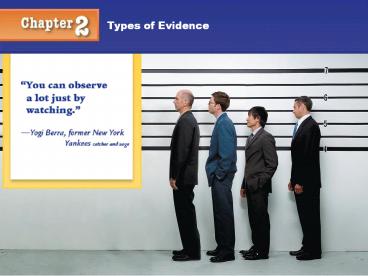Types of Evidence PowerPoint PPT Presentation
1 / 12
Title: Types of Evidence
1
Types of Evidence
2
Classification of Evidence
- Testimonial evidence is a statement made under
oathalso known as direct evidence or prima
facie evidence. - Physical evidence is any object or material that
is relevant in a crime also known as indirect
evidence. Examples are hair, fiber, fingerprints,
documents, blood, soil, drugs, toolmarks,
impressions, glass.
3
Eyewitness
- A police composite may be developed from the
witness testimony by a computer program or
forensic artist.
FACESa composite program by InterQuest
4
Physical Evidence
- Is generally more reliable than testimonial
evidence - Can prove that a crime has been committed
- Can corroborate or refute testimony
- Can link a suspect with a victim or with a crime
scene - Can establish the identity of persons associated
with a crime - Can allow reconstruction of events of a crime
5
Reconstruction
- Physical evidence can be used to answer questions
about - What took place at a crime scene
- The number of people involved
- The sequence of events
6
Examples of Transient Evidence
- Odorputrefaction, perfume, gasoline, urine,
burning, explosives, cigarette or cigar smoke - Temperaturesurroundings, car hood, coffee, water
in a bathtub, cadaver - Imprints and indentations footprints, teeth
marks in perishable foods, tire marks on certain
surfaces
7
Examples of Pattern Evidence
- Pattern evidencemostly in the form of imprints,
indentations, striations, markings, fractures, or
deposits
- Clothing or article distribution
- Gunpowder residue
- Material damage
- Body position
- Toolmarks
- Modus operandi
Blood spatter Glass fracture Fire burn
pattern Furniture position Projectile
trajectory Tire marks or skid marks
8
Examples of Conditional Evidence
- Lightheadlight, lighting conditions, lights on
or off - Smokecolor, direction of travel, density, odor
- Firecolor and direction of the flames, speed of
spread, temperature and condition of fire - Locationof injuries or wounds, of bloodstains,
of the victims vehicle, of weapons or cartridge
cases, of broken glass
- Vehiclesdoors locked or unlocked, windows opened
or closed, radio off or on, odometer mileage - Bodyposition and types of wounds rigor, livor,
and algor mortis - Scenecondition of furniture, doors and windows,
any disturbance or signs of a struggle
9
Classification of Evidence by Nature
- Biologicalblood, semen, saliva, sweat, tears,
hair, bone, tissues, urine, feces, animal
material, insects, bacteria, fungi, botanical
material - Chemicalfibers, glass, soil, gunpowder, metals,
minerals, narcotics, drugs, paper, ink,
cosmetics, paint, plastic, lubricants, fertilizer - Physicalfingerprints, footprints, shoeprints,
handwriting, firearms, tire marks, toolmarks,
typewriting - Miscellaneouslaundry marks, voice analysis,
polygraph, photography, stress evaluation,
psycholinguistic analysis, vehicle identification
10
Evidence Characteristics
- Individualcan be identified with a particular
person or a single source
Fingerprints
Blood DNA Typing
Classcommon to a group of objects or persons
11
Class vs. Individual Evidence
These fibers are class evidence there is no
way to determine if they came from this garment.
- The large piece of glass fits exactly to the
bottle it is individual evidence.
12
Class vs. Individual Evidence, continued
Which examples do you think could be individual
evidence?

